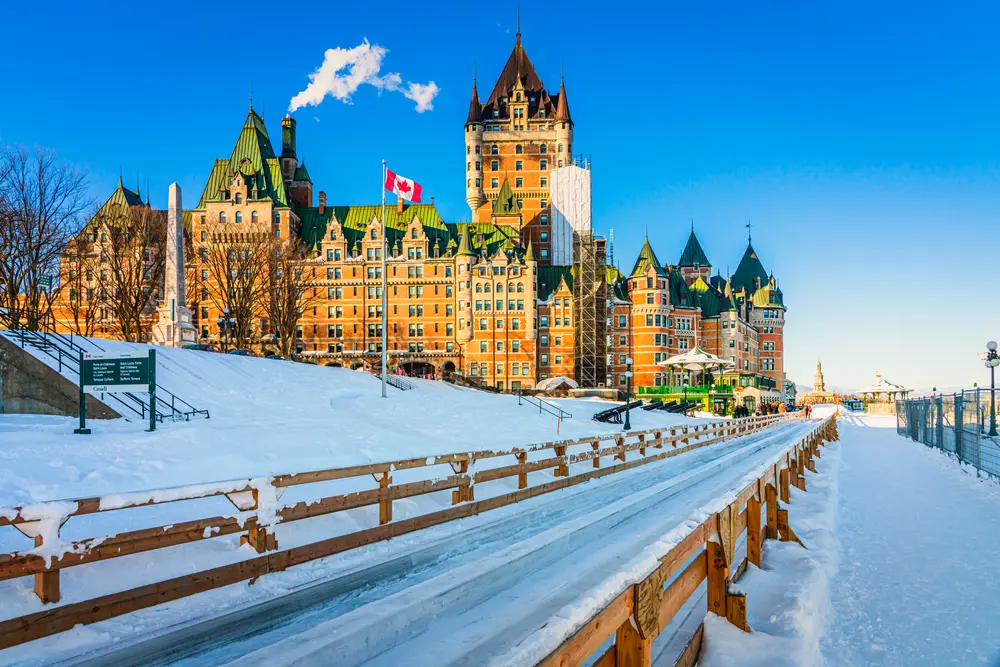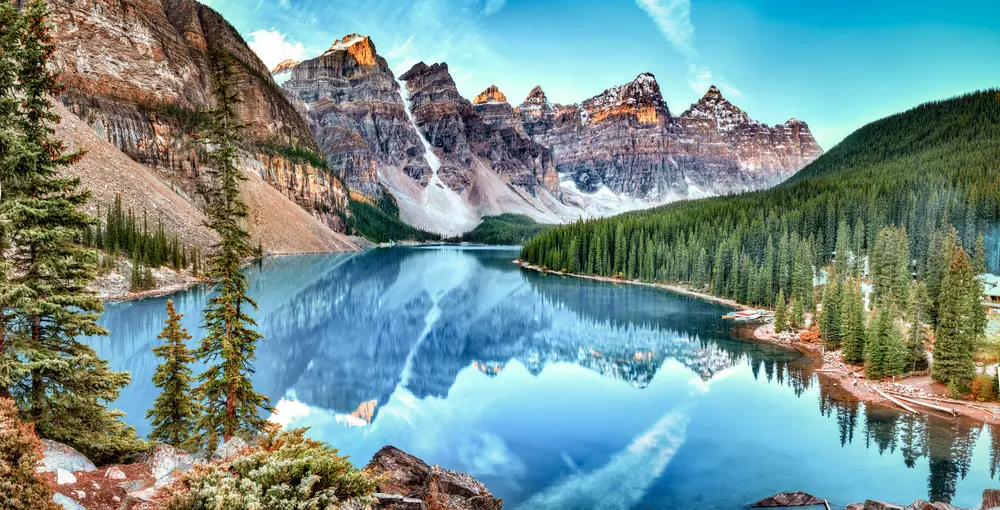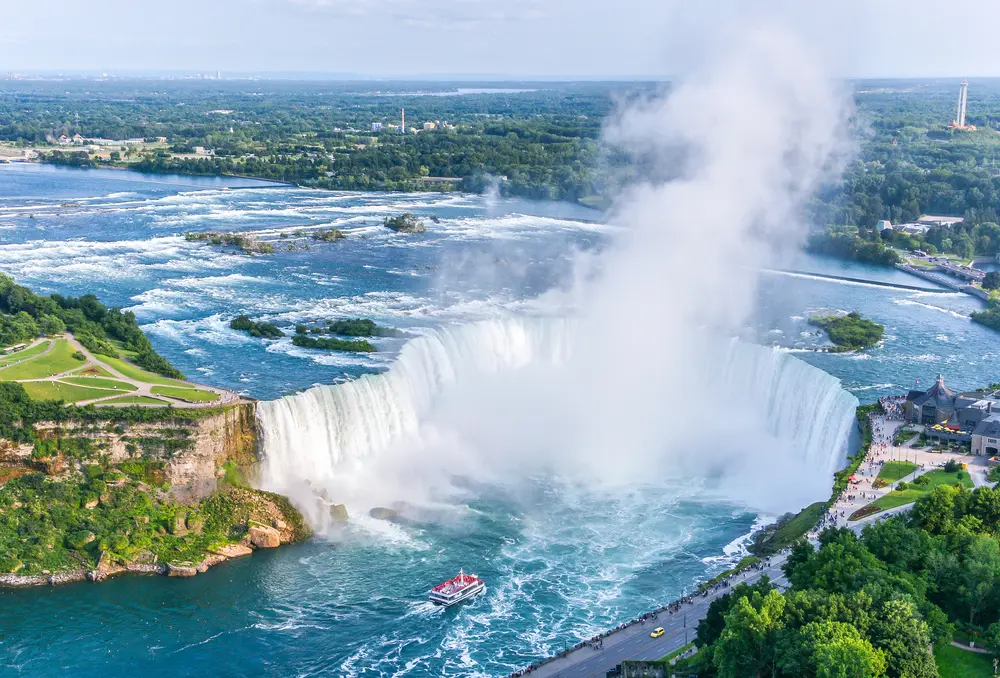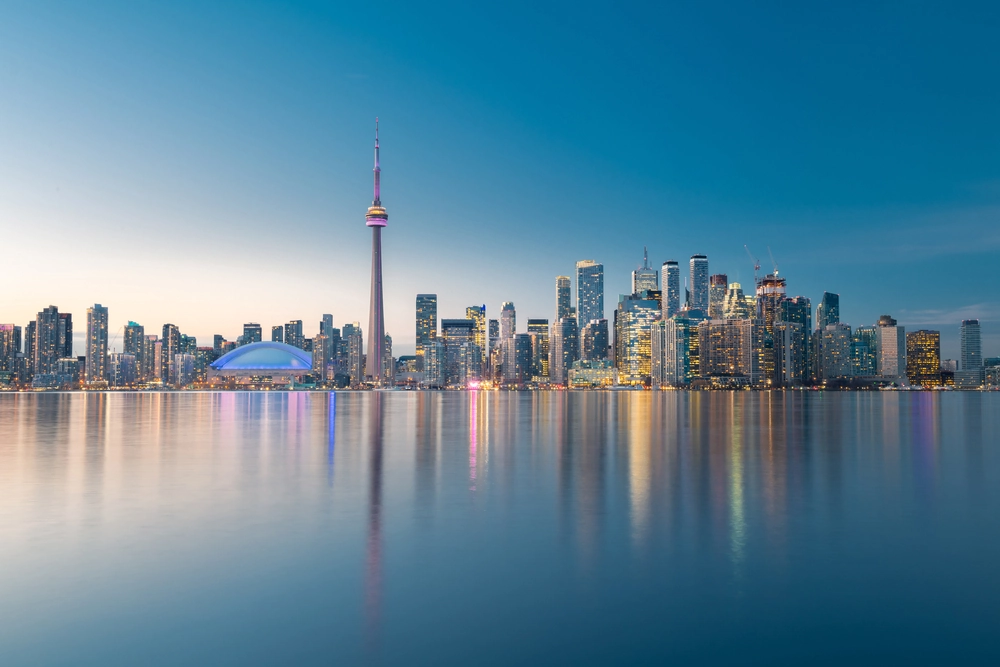
Canada is a vast and diverse country with something to offer everyone. From its stunning natural landscapes to its vibrant cities and rich culture, there’s no shortage of places to explore.
If you’re planning a trip to Canada, you’re in for a treat! In this blog post, we’ll share the 16 best places to visit in Canada, from hidden gems to iconic landmarks.
Whether you’re a nature lover, a foodie, or a history buff, you’re sure to find something to love on this list. So start planning your dream Canadian vacation today!
1. Banff National Park
Banff National Park Banff National Park is one of the most popular tourist destinations in Canada, and for good reason. This UNESCO World Heritage Site is home to some of the most stunning scenery in the world, including towering mountains, sparkling lakes, and glaciers.

In the summer, visitors can enjoy hiking, camping, fishing, and boating. In the winter, they can go skiing, snowboarding, and ice skating. The charming townsite of Banff offers shops, restaurants, and cultural attractions, as well as the Banff Upper Hot Springs, where visitors can soak in the mineral-rich waters while enjoying the mountain views. Lake Louise, an iconic destination in the park, is a great place to go for a walk, canoe ride, or simply relax and enjoy the scenery.
Banff is located in the Rocky Mountains of Alberta, Canada. It is about 145 km (90 miles) west of Calgary. To reach Banff by car, take the Trans-Canada Highway (Highway 1) west from Calgary. The drive takes about 1.5-2 hours. Once you arrive in Banff, you can park your car at your hotel or in one of the many public parking lots. The townsite is also pedestrian-friendly, so you can easily get around on foot or by bike.
2. Bay of Fundy
The Bay of Fundy is a natural wonder located on the east coast of Canada, between the provinces of New Brunswick and Nova Scotia. It is known for its extreme tides, which are the highest in the world. The tides can rise and fall by up to 50 feet (15 meters) in some places!
The Bay of Fundy is also home to a variety of marine life, including whales, dolphins, seals, and seabirds. It is a great place to go for whale watching, kayaking, and fishing. In addition to its natural attractions, the Bay of Fundy also has a rich history and culture. Visitors can visit museums, historical sites, and charming coastal towns.
To reach the Bay of Fundy by car, take the Trans-Canada Highway (Highway 1) east from Halifax or Saint John. Once you reach the Bay of Fundy, you can explore the coastal towns and attractions at your own pace.
3. Cape Breton Highlands National Park
Cape Breton Highlands National Park, a beautiful national park on the northern tip of Cape Breton Island, Nova Scotia, is known for its dramatic coastline, towering cliffs, and lush forests. The park is also home to a variety of wildlife, including moose, deer, bears, and eagles.
Cape Breton Highlands National Park is a great place to visit for all seasons. In the summer, visitors can enjoy hiking, camping, fishing, and swimming. In the winter, they can go skiing, snowboarding, and snowshoeing. In addition to its natural attractions, Cape Breton Highlands National Park also has a rich Celtic culture. Visitors can visit the Gaelic College in St. Ann’s to learn about the Gaelic language and culture, or enjoy traditional Celtic music and dance at one of the many festivals that are held throughout the year.
To reach Cape Breton Highlands National Park by car, take the Trans-Canada Highway (Highway 1) east from Halifax or Sydney. Once you reach Cape Breton Island, take the Cabot Trail (Highway 105) north. The park entrance is located on the Cabot Trail, about 2 hours north of Sydney.
4. Gros Morne National Park
Gros Morne National Park is a UNESCO World Heritage Site located on the west coast of Newfoundland. It is known for its stunning scenery, which includes towering mountains, fjords, waterfalls, and forests. The park is also home to a variety of wildlife, including moose, deer, bears, and whales.
In addition to its natural attractions, Gros Morne National Park also has a rich cultural history. You can visit the Gros Morne Discovery Centre to learn about the park’s geology, history, and culture. You can also visit the Tablelands, which is a unique landscape that was created by a massive meteorite impact.
To reach Gros Morne National Park by car, take the Trans-Canada Highway (Highway 1) west from St. John’s. Once you reach Corner Brook, Newfoundland, take Highway 430 south. The park entrance is located on Highway 430, about 90 minutes south of Corner Brook.
5. Jasper National Park
Jasper National Park is the largest national park in the Canadian Rockies, and it’s easy to see why it’s so popular. With its stunning mountain scenery, crystal-clear lakes, and abundant wildlife, Jasper has something to offer everyone.
Once there, you can plan activities like hiking the Skyline Trail, a popular trail that offers stunning views of the Athabasca Valley and the surrounding mountains, and visiting Maligne Lake, known for its crystal-clear water and dramatic mountain backdrop.
Jasper National Park is located in the Rocky Mountains of Alberta, about 370 km (230 miles) west of Edmonton and 404 km (251 miles) northwest of Calgary. To reach Jasper National Park by car, take the Trans-Canada Highway (Highway 16) west from Edmonton or Calgary. The drive takes about 4-5 hours.
6. Mont-Tremblant
Mont Tremblant is a popular tourist destination located in the Laurentian Mountains of Quebec. It is known for its stunning scenery, world-class skiing and snowboarding, and vibrant village atmosphere.
In addition to its natural attractions, Mont Tremblant also has a charming village atmosphere with shops, restaurants, and cultural attractions. You can also visit the Casino de Mont Tremblant or the Scandinave Spa Mont Tremblant to relax and rejuvenate.
Mont Tremblant is located in the Laurentian Mountains of Quebec, about 130 km (80 miles) northwest of Montreal. To reach Mont Tremblant by car, take the Autoroute 15 north from Montreal. Exit at exit 93 and follow the signs to Mont Tremblant. The drive takes about 1.5 hours.
7. Montreal
Montreal is a vibrant and cosmopolitan city known for its French culture and lively nightlife.
Old Montreal is the historic heart of the city, with cobblestone streets, charming shops, and art galleries. You can also visit the Notre-Dame Basilica of Montreal, a beautiful cathedral with stunning stained glass windows.
Montreal is also known for its delicious food, including poutine, bagels, and smoked meat. Be sure to try some of the local cuisine while you’re in town!
Montreal is located in the province of Quebec, about 200 km (120 miles) east of Ottawa and 500 km (310 miles) northeast of Toronto. To reach Montreal by car, take the Autoroute 40 east from Ottawa or Toronto. The drive takes about 2-3 hours.
8. Niagara Falls
Niagara Falls is one of the most popular tourist destinations in North America. It is located on the border between Canada and the United States, and is made up of three waterfalls: the Horseshoe Falls, the American Falls, and the Bridal Veil Falls. The Horseshoe Falls is the largest of the three, and is one of the most powerful waterfalls in the world.

Niagara Falls is a truly awe-inspiring sight, and visitors can get up close to the falls by taking a boat tour, or by walking along the many walkways and viewing platforms.
To reach Niagara Falls by car from Toronto, take the Queen Elizabeth Way (QEW) west. The QEW is a scenic highway that connects Toronto to Niagara Falls. The drive takes about 1.5 hours.
If you’re in the United States, you can take Interstate 190 north from Buffalo, New York. The drive takes about 30 minutes.
9. Okanagan Valley
The Okanagan Valley is a beautiful region in British Columbia, known for its stunning scenery, mild climate, and abundance of outdoor activities. The valley is home to a number of lakes, rivers, and mountains, as well as vineyards, orchards, and wineries.
Known for its fresh food and local wine, the Valley has a number of restaurants and wineries that offer visitors a chance to sample the region’s culinary delights.
To reach the Okanagan Valley by car from Vancouver, take Highway 99 east – the drive takes about 4 hours. From Calgary, take Highway 1 west – the drive takes about 5 hours.
10. Prince Edward Island
Prince Edward Island is a small island province in eastern Canada, known for its beautiful scenery, fresh seafood, and Anne of Green Gables.
The island has two national parks: Prince Edward Island National Park and Greenwich National Park. Prince Edward Island National Park is home to towering red cliffs, rolling sand dunes, and lush forests. Greenwich National Park is a smaller park that is known for its red sandstone cliffs and picturesque beaches.
To reach Prince Edward Island by car from the mainland, you can take the Confederation Bridge. The Confederation Bridge is a 12.9-kilometer bridge that connects the island to New Brunswick. The drive from Moncton, New Brunswick, to Charlottetown, Prince Edward Island, takes about 1 hour.
11. Quebec City
Quebec City is the capital of the province of Quebec, and is one of the oldest and most historic cities in North America. It is known for its well-preserved French colonial architecture, its vibrant culture, and its stunning natural setting.
This is a city steeped in history and culture: the Old Town is a UNESCO World Heritage Site and is home to a number of historical buildings and attractions, including the Château Frontenac, the Citadelle of Quebec, and the Notre-Dame de Québec Basilica-Cathedral. Quebec City is also home to a vibrant arts and culture scene, with a number of museums, galleries, and theaters.
To reach Quebec City by car from Toronto, take Highway 401 east to Montreal, and then take Highway 20 east. The drive takes about 6 hours.
12. Toronto
Toronto is the largest city in Canada and is a vibrant and multicultural metropolis. It is known for its thriving arts, its world-class attractions, and its diverse population. This diversity is reflected in the city’s food scene, its culture, and its neighborhoods.

The city is home to a number of museums, galleries, theaters, and music venues. Toronto also hosts a number of festivals and events throughout the year, including the Toronto International Film Festival and the Caribana festival.
Some of the most famous attractions in the city include the CN Tower, the Royal Ontario Museum, and the Hockey Hall of Fame. The city is also home to a number of parks and gardens, including High Park and the Toronto Islands.
To reach Toronto by car from the west, take Highway 401 east. The drive from Detroit to Toronto takes about 4 hours.
13. Vancouver
Vancouver is a vibrant coastal city in British Columbia, Canada. It is known for its stunning natural beauty, diverse culture, and mild climate. Vancouver is surrounded by mountains, ocean, and forests, offering a variety of outdoor activities to enjoy, including hiking, biking, skiing, kayaking, and whale watching. The city also has a thriving arts and culture scene, with a variety of museums, galleries, and theaters.
Vancouver also has a thriving culinary scene, with a variety of restaurants serving everything from fresh seafood to international cuisine. The city is also home to a number of festivals and events throughout the year, including the Vancouver International Film Festival, the Vancouver Folk Music Festival, and the Celebration of Light fireworks festival.
From the east, take the Trans-Canada Highway west. The Trans-Canada Highway is a scenic highway that connects Vancouver to the rest of Canada. The drive from Toronto to Vancouver takes about four days.
From the south, take Interstate 5 north to Seattle, Washington. From Seattle, take Highway 99 north to Vancouver. The drive from Seattle to Vancouver takes about two hours.
14. Whistler
Whistler is a world-renowned mountain resort village in British Columbia. It is located about 125 kilometers north of Vancouver, and is known for its stunning alpine scenery, world-class skiing and snowboarding, and vibrant village atmosphere.
In the winter, skiers and snowboarders from all over the world come to Whistler to experience its world-class slopes. In the summer, Whistler is a great place to enjoy hiking, biking, fishing, and other outdoor activities.
To reach Whistler by car from Vancouver, take Highway 99 north towards Squamish. After about 45 minutes, you will reach the Sea to Sky Highway. Continue on the Sea to Sky Highway for about 75 minutes, and you will arrive in Whistler.
The drive from Vancouver to Whistler is one of the most scenic in Canada. The Sea to Sky Highway winds its way through the Coast Mountains, offering stunning views of Howe Sound and the surrounding mountains.
15. Whitehorse
Whitehorse is the capital of the Yukon Territory, and is located in the northwestern corner of Canada. It is a small city with a population of about 36,000 people, but it is surrounded by stunning wilderness and offers a variety of outdoor activities and attractions.
Whitehorse is a great place to enjoy a variety of outdoor activities, including hiking, biking, fishing, camping, and skiing. There are also a number of tour operators that offer guided activities such as whitewater rafting, dog sledding, and aurora borealis viewing.
Whitehorse has a rich history and culture, and there are a number of historical sites to visit, such as the S.S. Klondike and the MacBride Museum of Yukon History. Whitehorse is also home to a number of First Nations communities, and there are a number of opportunities to learn about their culture and traditions.
To reach Whitehorse by car, you can take the Alaska Highway. The Alaska Highway is a scenic highway that connects Whitehorse to Fairbanks, Alaska, and the rest of North America.
The drive from Fairbanks to Whitehorse is a 12-hour journey, mostly on paved roads with some unpaved sections. Be sure to check the road conditions before you go and allow plenty of time for your trip.
16. Manitoulin Island
Manitoulin Island is the largest freshwater island in the world, located in Lake Huron, Ontario. The Island has a number of beautiful beaches, including Providence Bay Provincial Park, Sandcastle Beach, and Kagawong Beach.
The island is also home to a number of Indigenous communities, and there are many opportunities to learn about their culture and traditions. There are many historical sites to visit as well, such as the Great Spirit Circle Trail and the Ojibwe Cultural Centre.
To reach Manitoulin Island by car, you can take the Trans-Canada Highway to Sudbury, Ontario. From Sudbury, take Highway 17 north to Little Current. In Little Current, take the swing bridge to Manitoulin Island.
The drive from Sudbury to Manitoulin Island takes about 3 hours. Like the road from Fairbanks to Whitehorse, the drive is mostly paved, but there are some unpaved sections of road, so be careful of road conditions before planning your trip.
Conclusion
Canada is a vast and beautiful country, with a diverse range of landscapes and attractions to offer visitors – and what better way to experience Canada than by car? Road tripping across Canada allows you to see the country at your own pace and stop at all the places that interest you along the way. You can also visit some of Canada’s most remote and off-the-beaten-path destinations, which would be difficult or impossible to reach by public transportation.
If you’re planning a road trip across Canada, be sure to check out the Rentcars website for the best deals on car rentals, and choose from a wide variety of vehicles.
Book your rental car today and start planning your Canadian adventure!
Frequently asked questions
What is considered the most beautiful place in Canada?
Canada is renowned for its breathtaking natural beauty, making it difficult to pinpoint a single “most beautiful” place, as it largely depends on personal preferences. However, some of the most frequently mentioned stunning locations include the turquoise waters of Lake Louise in Banff National Park, the pristine wilderness of Jasper National Park, the rugged coastline of Vancouver Island’s Pacific Rim National Park Reserve, the historic charm of Old Quebec City, and the dramatic landscapes of the Canadian Rockies in general, all of which offer captivating and diverse experiences for travelers seeking beauty in different forms.
What is the #1 tourist attraction in Canada?
Canada’s top tourist attraction is often considered to be Niagara Falls, which straddles the border between Ontario and New York in the United States. The majestic falls, consisting of Horseshoe Falls, American Falls, and Bridal Veil Falls, are a natural wonder of immense beauty and power, drawing millions of visitors annually. Tourists come to witness the thundering cascades, take boat tours, explore nearby attractions, and enjoy the surrounding natural and cultural experiences, making Niagara Falls a globally recognized and highly popular destination in Canada.
Where do most Americans vacation in Canada?
Some of the most popular destinations for American tourists include cities like Toronto and Vancouver, which offer a blend of cultural attractions, shopping, and diverse dining experiences. The nearby natural beauty of places like Banff National Park in the Canadian Rockies and Niagara Falls is also highly sought after. Additionally, coastal regions such as Victoria on Vancouver Island and the maritime provinces like Nova Scotia and Prince Edward Island are favored for their scenic landscapes and historical charm.
What is the ideal destination for a first-time visit to Canada?
For a first-time visit to Canada, Toronto is often considered one of the best destinations. Canada’s largest city offers a dynamic blend of cultural experiences, world-class dining, diverse neighborhoods, and iconic attractions such as the CN Tower, Royal Ontario Museum, and the Distillery District. It provides a great introduction to Canadian urban life while still being close to Niagara Falls. Additionally, Toronto’s multicultural vibe reflects Canada’s overall diversity, making it an excellent starting point to explore the country’s culture and landscapes.







Leave a Reply